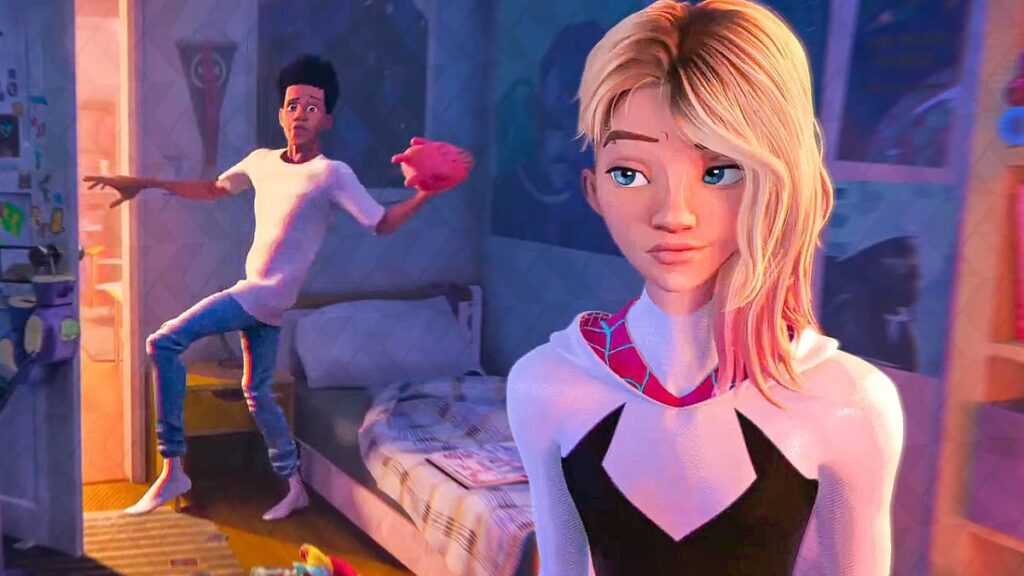When Spider-Man: Into the Spider-Verse burst onto theatrical screens with aplomb in 2018, it was already known a sequel was potentially in development. Such was the confidence of the producers (Avi Arad, Amy Pascal, Phil Lord, Christopher Miller and Christina Steinberg) and Sony Pictures Animation they were onto something big.
Fast forward to 2023 – with all the success and hype surrounding the first film, the giddy anticipation of the sequel Spider-Man: Across the Spider-Verse was palpable. While sequels can all too often be a rather deflating experience, this one has served up all the treats and delights fans and audiences alike could hope for. And then some.
Review: Spider-Man: Far From Home (2019)
Directed by Joaquim Dos Santos, Kemp Powers and Justin K. Thompson, Spider-Man: Across the Spider-Verse is an animated masterpiece sure to excite both fans of the franchise and animation aficionados alike. The film’s focus is on the back stories and subsequent progress of Spider-Woman Gwen Stacy (Hailee Steinfeld) and Spider-Man Miles Morales (Shameik Moore) in their respective universes as they struggle to balance their superhero personas with their earthly selves. Both feel the burden of meeting expectations of their respective fathers and endure feelings of frustration and isolation in keeping their superhero secret from those they love most.
The film opens 16 months after the events of the first film, with Gwen evading her father’s hunt for her superhero persona who he suspects killed her best friend, Peter Parker. In carrying on her superhero duties, she goes to the Guggenheim Museum to investigate reports of a disturbance where she encounters a version of Vulture from an alternate universe. While the two engage in combat, Jessica Drew and Miguel O’Hara – two alternative Spider-People appear from their alternate universe and assist Gwen to battle Vulture.
After the battle is over, Gwen is confronted with her father as Spider-Woman and in seeking to explain the events surrounding Peter Parker’s death, reveals her identity as his daughter. Shocked and then dismayed, her father persists in seeking to arrest Gwen. Jessica and Miguel offer Gwen an opportunity to escape her father and her universe and join them as a member of the Spider-Society. Loss of any hope of making peace with her father, Gwen accepts their offer and jumps through the portal.
Review: Spider-Man: Into the Spider-Verse
Jumping to Morales’ universe, we explore his own personal battles with his parents while performing his own superhero duties, Miles encounters The Spot, a scientist whose body is covered with ‘black holes’ which are in fact portals. Spot explains how he was caught in the collider explosion which killed Peter Parker’s Spider-Man in their universe resulting in his body now being in its current form. Spot blames Miles for his misfortune as Peter was killed in an effort to save Miles and vows to seek revenge. However, in battling Miles, Spot is accidentally transported into a void where he discovers the ability to transport himself to other universes where he can harness the energy from other colliders to attain greater powers.
The two introductions form the premise for the remainder of the film’s 140 minute running time. With numerous leaps through portals from one alternate universe to another providing fresh animated takes on the Manhattan we are usually familiar with. Including a futuristic version with flying cars, a comic book themed version saluting the fans (garnering cheers from the audience in this writer’s screening), and another known as Mumbattan, being based on Spider-Man India comic book series.
These journeys to alternate universes provide endless opportunities for team Sony Pictures Animation to work their magic and they deliver in spades. Put simply, there is no other animated film close to the animated genius displayed in Spider-Man: Across the Spider-Verse. And come awards season, this will be proven with the numerous accolades it is sure to earn.
Animation and Canadian Short Films Win Spread of Awards at 7th Femme Filmmakers Festival
Not taking a back seat is a score by Daniel Pemberton (from the previous film) and soundtrack which provide award-worthy support to their visual brethren. It may well be a film that will see audiences making repeat visits to theatres to ensure they don’t miss any of the countless and delightful tributes, easter eggs and cameos on offer.
The pace of the film is lightning fast – slowing down to provide moments of pure emotion and vulnerability in the lives of Gwen and Miles. Together with a brilliant screenplay which also provides genuine humour and levity, the animators and writers have weaved a masterful work of art which will delight audiences both young and the young at heart.

